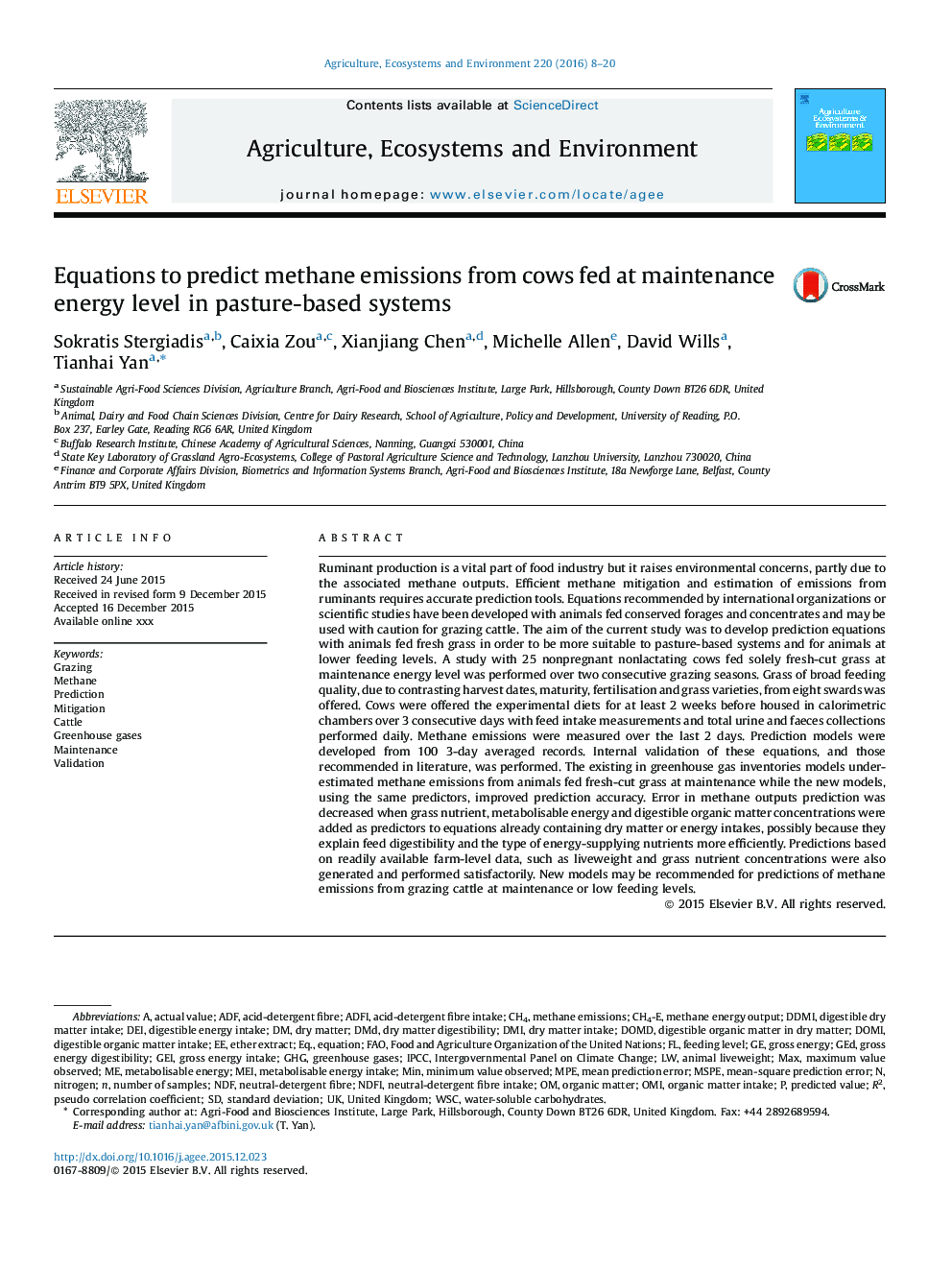| کد مقاله | کد نشریه | سال انتشار | مقاله انگلیسی | نسخه تمام متن |
|---|---|---|---|---|
| 8487476 | 1552032 | 2016 | 13 صفحه PDF | دانلود رایگان |
عنوان انگلیسی مقاله ISI
Equations to predict methane emissions from cows fed at maintenance energy level in pasture-based systems
ترجمه فارسی عنوان
معادلات برای پیش بینی انتشار گاز متان از گاوهای تغذیه شده در سطح انرژی تعمیر و نگهداری در سیستم های مبتنی بر مرتع
دانلود مقاله + سفارش ترجمه
دانلود مقاله ISI انگلیسی
رایگان برای ایرانیان
کلمات کلیدی
GHGGEDOMIGEIDMDMAXIPCCADFINDFWSCMSPEDOMICH4MPEDOMDmean prediction errorDDMINDFIDMIdigestible organic matter in dry matterADFacid-detergent fibreMEI - MAYDEI - ازValidation - اعتبار سنجیMethane emissions - انتشارات متانstandard deviation - انحراف معیارmetabolisable energy - انرژی قابل متابولیسمgross energy - انرژی ناخالصMitigation - تسکین دهندهNumber of samples - تعداد نمونه هاMin - حداقلFood and Agriculture Organization of the United Nations - سازمان غذا و کشاورزی سازمان ملل متحدFeeding level - سطح تغذیهether extract - عصاره اترMaintenance - عملیات نگهداری و تعمیراتFAO - فائوneutral-detergent fibre - فیبر خنثی مواد شویندهorganic matter - ماده آلیdry matter - ماده خشکMethane - متان digestible energy intake - مصرف انرژی قابل هضم استgross energy intake - مصرف انرژی ناخالصorganic matter intake - مصرف ماده آلیdigestible organic matter intake - مصرف ماده آلی قابل هضم استdry matter intake - مصرف ماده خشکEq. - معادلهEquation - معادلهNitrogen - نیتروژنdry matter digestibility - هضم ماده خشک مادهIntergovernmental Panel on Climate Change - هیات بین دولتی در مورد تغییرات اقلیمیUnited Kingdom - پادشاهی متحده بریتانیاPrediction - پیش بینیGrazing - چِراWater-soluble carbohydrates - کربوهیدرات های محلول در آبGreenhouse gases - گازهای گلخانه ایCattle - گاو
موضوعات مرتبط
علوم زیستی و بیوفناوری
علوم کشاورزی و بیولوژیک
علوم زراعت و اصلاح نباتات
چکیده انگلیسی
Ruminant production is a vital part of food industry but it raises environmental concerns, partly due to the associated methane outputs. Efficient methane mitigation and estimation of emissions from ruminants requires accurate prediction tools. Equations recommended by international organizations or scientific studies have been developed with animals fed conserved forages and concentrates and may be used with caution for grazing cattle. The aim of the current study was to develop prediction equations with animals fed fresh grass in order to be more suitable to pasture-based systems and for animals at lower feeding levels. A study with 25 nonpregnant nonlactating cows fed solely fresh-cut grass at maintenance energy level was performed over two consecutive grazing seasons. Grass of broad feeding quality, due to contrasting harvest dates, maturity, fertilisation and grass varieties, from eight swards was offered. Cows were offered the experimental diets for at least 2 weeks before housed in calorimetric chambers over 3 consecutive days with feed intake measurements and total urine and faeces collections performed daily. Methane emissions were measured over the last 2 days. Prediction models were developed from 100 3-day averaged records. Internal validation of these equations, and those recommended in literature, was performed. The existing in greenhouse gas inventories models under-estimated methane emissions from animals fed fresh-cut grass at maintenance while the new models, using the same predictors, improved prediction accuracy. Error in methane outputs prediction was decreased when grass nutrient, metabolisable energy and digestible organic matter concentrations were added as predictors to equations already containing dry matter or energy intakes, possibly because they explain feed digestibility and the type of energy-supplying nutrients more efficiently. Predictions based on readily available farm-level data, such as liveweight and grass nutrient concentrations were also generated and performed satisfactorily. New models may be recommended for predictions of methane emissions from grazing cattle at maintenance or low feeding levels.
ناشر
Database: Elsevier - ScienceDirect (ساینس دایرکت)
Journal: Agriculture, Ecosystems & Environment - Volume 220, 15 March 2016, Pages 8-20
Journal: Agriculture, Ecosystems & Environment - Volume 220, 15 March 2016, Pages 8-20
نویسندگان
Sokratis Stergiadis, Caixia Zou, Xianjiang Chen, Michelle Allen, David Wills, Tianhai Yan,
